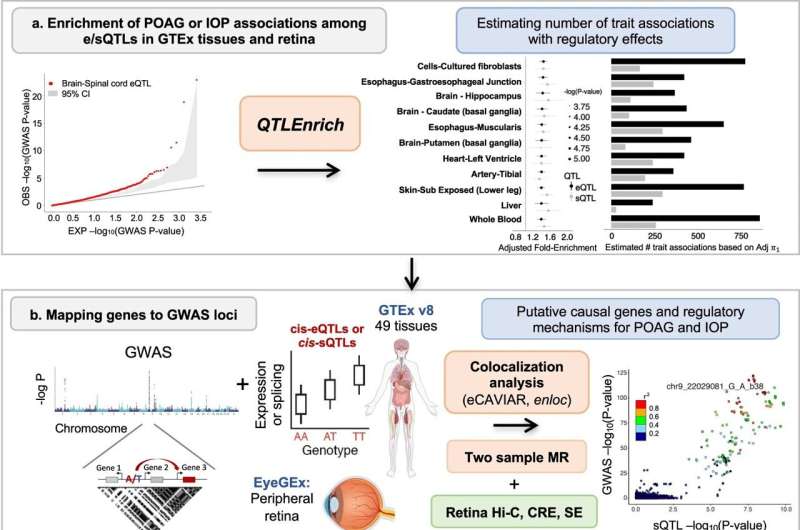This article has been reviewed according to Science X's editorial process and policies. Editors have highlighted the following attributes while ensuring the content's credibility:
fact-checked
trusted source
proofread
Researchers identify genes and cell types that may have causal role in primary open-angle glaucoma formation

Although primary open-angle glaucoma (POAG) is the leading cause of blindness in people over the age of 55, there remains no cure for the disease and its biological mechanisms are not well understood. Elevated intraocular pressure (IOP) is a major risk factor for the disease, but many patients with glaucoma have normal eye pressure and still lose vision.
In a new study published this past month in Nature Communications, researchers from Mass Eye and Ear, led by Ayellet Segrè, Ph.D., conducted a comprehensive study that combined genetic discoveries from a large cross-ancestry genome-wide association study meta-analysis of POAG, led by Janey Wiggs, MD, Ph.D., and a large meta-analysis of IOP with genetic regulation studies and single cell expression measurements in glaucoma-relevant eye tissues.
In doing so, they uncovered key genes, biological processes, and cell types that may affect the pathogenesis of POAG in IOP-dependent and independent manners.
Using integrative analyses, they identified hundreds of genes and regulatory effects underlying over 100 loci associated with POAG and/or IOP that may contribute to glaucoma risk through altered gene expression levels. These genes are enriched in biological pathways implicated in disease mechanisms, including elastic fiber formation and extracellular matrix organization, vascular development, and neuronal-related processes.
Furthermore, by utilizing single-nucleus gene expression data from the aqueous humor outflow pathways, retina, and the optic nerve head and surrounding posterior tissues, as part of a cell atlas of the whole eye led by Josh Sanes, Ph.D. from the Department of Molecular and Cellular Biology at Harvard University, the researchers identified known and less well-established cell types in which gene dysregulation may affect optic nerve degeneration.
This included fibroblasts in the conventional and unconventional outflow pathways, astrocytes in the retina and optic nerve head, oligodendrocytes and vascular cells in the optic nerve head, and fibroblasts in the surrounding region of the optic nerve head.
Pathways identified in their analysis can impact various structures in the eye, pointing to numerous potential mechanisms that can interact with different genes and cell types that may contribute to POAG. These findings provide new insights regarding gene expression and post-transcriptional gene regulation that could improve drug design for glaucoma.
"Our work has generated new insights into POAG mechanisms, which could inform the development of novel therapies targeting IOP reduction and neuroprotection," said Segrè.
"For example, this research suggests that targeting neuronal support cells, in addition to retinal ganglion cells, may be important to consider in the design of new drug and cell therapies. Through our ongoing work aimed at detecting genetic regulation of gene expression in glaucoma-relevant eye tissues, we hope in the future, to provide a more complete understanding of POAG risk and IOP variation."
More information: Andrew R. Hamel et al, Integrating genetic regulation and single-cell expression with GWAS prioritizes causal genes and cell types for glaucoma, Nature Communications (2024). DOI: 10.1038/s41467-023-44380-y




















